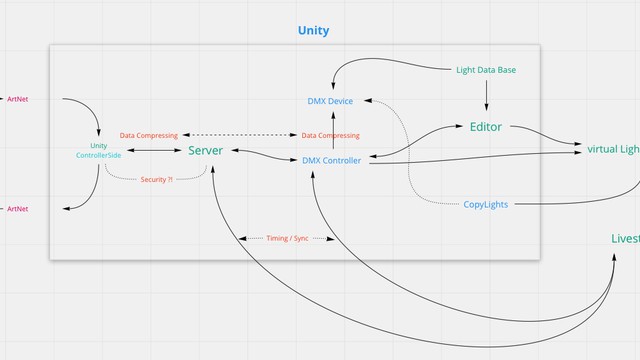XRchitecture – the cross-reality event-platform 2021, Germany, Hamburg
An editor/control room software for placing fixtures and transmitting DMX/ArtNet signals to both realities.



The XRchitecture event platform serves as a pilot for exploring hybrid event solutions. The goal is to not only experience a show on site, but also in virtual space (VR) with VR-hardware. In the future, the developed solutions should be available to the event industry, to enable the integration of VR into a real event without much additional effort. This could result, for example, in event formats in which one part of the audience participates on site and another part via virtual. The subproject presented here allows the simultaneous manipulation of light and media architecture installations via the same interface, a light console.
The XRchitecture event platform creates new ways of communication by interweaving real performances with virtual multi-user events. Any event can be experienced simultaneously in the real and virtual world. Artists can broadcast their performances live in both worlds. Synchronized manipulations of performances for hybrid events become possible via common interfaces for controlling sound, light and video. Since 2020 and most likely 2021, we live in a reality where social events, festivals, concerts and conferences are cancelled and cannot be easily repeated. Clubs and other nightlife venues will remain closed indefinitely. This poses social and financial challenges for visitors as well as artists, event organizers and their teams. With the XRchitecture project, we as event technicians wanted to find an answer to this and dove from our original work for real events into an unknown virtual one. We would like to introduce a subproject of the XRchitecture platform, an editor for event lighting, because video and audio streams have already been optimized for our digital event formats through appropriate encoding in other projects. But control signals for luminaires like DMX and ArtNet are usually only available for local events. For a virtual event, this control signal needs to be re-encoded and optimized. An existing solution for ArtNet integration in Unity was adapted to control virtual luminaires with a lighting console (GrandMA) in the local network.This project will test how ArNet packages can be optimized to create an immersion of a virtual light show. In order to test a hybrid event format, a historical facade at the Carl-Bosch Gymnasium in Ludwigshafen was illuminated in cooperation with students from the Beuth University of Applied Sciences Berlin, while the transmission into VR was controlled and monitored via servers in Hamburg.
https://xrchitecture.de/vr-welt/
Details
Team members : Tom Milter (HAW Hamburg), Clara Grebenstein, Lukas Lobmann, Lukas Riffel (Beuth University of Applied Sciences Berlin)
Supervisor : Dipl. Des. Anke von der Heide
Institution : Hamburg University of Applied Sciences
Funding agencies : Hamburg Innovation
Descriptions
Technical Concept : Usual ArtNet packets are too large to send via internet. While light consoles send 30, 60 or more packets per second, it remains unclear how many are needed to create a light-show in VR. However, once a user is outside the internal network and participates in a live event with own VR-hardware, these control signals have to be transmitted via the internet. To cope with this problem an editor/control-room software was developed. It receives control packets via the lighting-desks network and sends them to our system. The editor also functions as a visualizer for designers. Is the XR-app already built, last minute changes can be made, such as fixture positions etc., a usual procedure of real show setups. The users will download the changes as an update. An additional operator can engage as a controller to receive diagnostic data, while configuring the data rate or other parameters live.
Visual Concept : For a test event, a storytelling for the facade of the Carl-Bosch Gymnasium in Ludwigshafen was developed within one week. Playing with the conditions of the building, e.g. backlighting of windows and direct lighting of the façade, was the main focus. The concept was realized with 65x LED Pars/Bars/Floods, 4x Martin Mac 2000 Profile II, 10x TBF Spraymaster, 2x MagicFX Flamaniac and a control mix of grandMA3 onPC CommandWing, Resolume Arena. The broader topic of the installation of today´s event technology students was the pleasure to returning to their former school and joining in their school-event-workshop, to revive the closed building with a 5 minute looped light show. Starting with the representation of the pandemic situation with a harder rhythm of red and yellow lights and flamethrowers, a middle section reflecting prohibited events and a cheerful ending hoping for a swift end.
Credits
Tom Milter
Lukas Runge
Tom Milter
Lukas Runge
Tom Milter